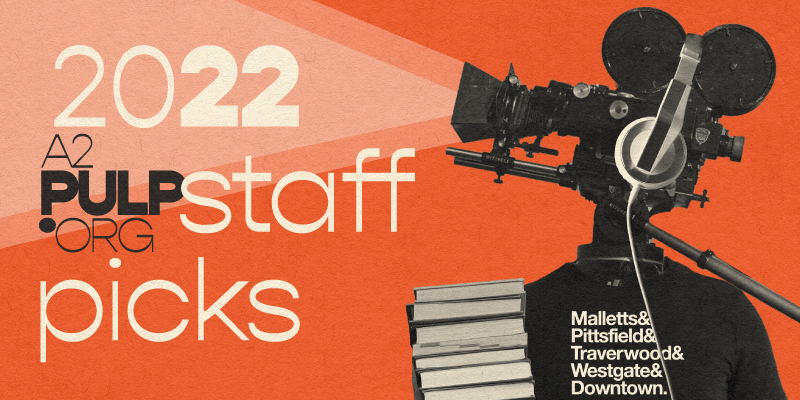AADL 2022 Staff Picks: Homepage

Don't ever write a year-in-review intro before you've had lunch. See below for reasons:
2022 is Pulp’s sixth year of compiling a delectable list of Ann Arbor District Library staff picks, featuring a smorgasbord of media to review and devour. With an insatiable hunger for books, films, TV shows, podcasts, music, and more, our AADL staffer suggestions will whet your appetite for anything you may have missed in 2022—or from previous years.
Because who can keep current with everything on the media menu these days?
The current media landscape is a 24-hour grocery store with everything everywhere available all at once. It’s decision paralysis at the deli counter, so consider us your Instacart shoppers for things to read, watch, play, listen to, and experience. (Apologies if we missed anything on your shopping list, and we hope our substituting a banana for that frozen pizza is OK.)
With more than 36,000 words to ingest in the 2022 Staff Picks, we’ve divided everything into four separate courses so you can enjoy each portion at your leisure:
➥ AADL 2022 Staff Picks: Words
➥ AADL 2022 Staff Picks: Screens
➥ AADL 2022 Staff Picks: Audio
➥ AADL 2022 Staff Picks: Pulp Life
If you feel inspired as you eat up our words, let us know in the comments sections what you sank your teeth into this year. Your tasty tips can be from 2022 or any other era; it just needs to encompass whatever art, culture, or entertainment you enjoyed over the past year.
Now, open up these posts and chow down.
We’re off to make some spaghetti.
AADL 2022 Staff Picks: Pulp Life

➥ AADL 2022 Staff Picks: Homepage
➥ AADL 2022 Staff Picks: Words
➥ AADL 2022 Staff Picks: Screens
➥ AADL 2022 Staff Picks: Audio
AADL 2022 STAFF PICS: PULP LIFE
Games, apps, sports, outdoors, and any other kind of hard-to-categorize cultural and life activities:
Sparks and Sawdust: Erin Hahn's romance novel "Built to Last" reunites childhood sweethearts on a home renovation TV show

A house is not the only thing being fixed up in Erin Hahn’s new novel, Built to Last.
Two childhood stars, Shelby Springfield and Cameron Riggs, try to rekindle their love when they are brought back together for a home renovation TV program set in Michigan—though things get off to a rocky start, not unlike how things ended. Lyle Jessup, their other costar and the person who caused conflict when Shelby dated him after Cameron, turns out to be the one who brings them together with his TV pilot proposal. While Lyle never left Hollywood and its gossip, Shelby and Cameron have diverged on their paths and must find out if they can work together again—and even have another try at a relationship.
During a visit from Lyle, who becomes the showrunner, the now sober Shelby watches Cameron’s longtime friends, Beth and Kevin, at their bar:
My cheeks hurt from smiling so hard and the fizzy ginger ale does a little swirl in my stomach. These two make it look so simple. You meet, you fall in love, you get married and have babies, and you spend the rest of your life with that one person who likes you best, who you like best.
Both Cameron and Shelby are wildly attracted to each other, but the question becomes whether they can push past the drama of filming and reconnect.
Cameron reflects, “Maybe I wasn’t looking for something to tie me down. Maybe I’ve been looking for someone, an anchor. And not just any someone. Not like the proverbial 'someone,' but her. As in, she is the only one.” He senses how important Shelby is, but their relationship could either be just a pivotal part of growing up or a long-lost—and now found—real deal.
Hahn lives in Ann Arbor with her husband and two kids. Previously, I interviewed her about her last book, 2021's Never Saw You Coming. We connected again to discuss Built to Last, Hahn’s fourth book.
David Fenton's "The Activist’s Media Handbook" traces his life in the media, from the "Ann Arbor Sun" to progressive public relations

Activist and public relations firm founder David Fenton launched his very first PR campaign in Ann Arbor in 1971: Fenton worked to get John Sinclair out of prison where he was serving a sentence for giving drugs to an undercover agent.
Following this effort, Fenton wrote for the countercultural newspaper Ann Arbor Sun where he worked on a campaign to increase sales by running a contest called “Win a Pound of Colombian Marijuana.”
Fenton’s new book, The Activist’s Media Handbook: Lessons From 50 Years As a Progressive Agitator, spends two chapters on his time in A2 and also details what happened before and after.
Of his time working at the newspaper and in activism, Fenton writes:
Things to Do: Pulp Event Roundup for November

To fill up your November calendar, we’ve compiled a comprehensive list of arts-related events, exhibits, and more throughout Washtenaw County. Check out some local cool happenings in music, visual art, theater and dance, and written word and film.
MUSIC
Bill Edwards
November 11
Canterbury House, Ann Arbor
Ann Arbor singer-songwriter and multi-instrumentalist Bill Edwards performs tracks from his new Americana album, Thirteen Stories. Throughout his latest release, Edwards pens sentimental stories from different perspectives, including a hall-of-fame baseball player, a seasoned songwriter, and a nostalgic boater. Read our preview and interview here.
Nervous But Excited
November 11
The Ark, Ann Arbor
Ten years after their sold-out finale at The Ark, the local folk duo of Kate Peterson and Sarah Cleaver reunite for one of their final Nervous But Excited performances. Their repertoire ranges from smart, introspective narratives to the tactfully political while interspersing songs of love and loss.
Olivia Van Goor
November 11
Blue Llama Jazz Club, Ann Arbor
The Milford jazz vocalist is influenced by swing and bebop jazz from the mid-20th century. Van Goor unearths and reshapes gems from the Great American Songbook and other jazz standards in a way that’s beyond replicating what has already been done before. Read our past interview with Van Goor here.
Deep Dive: Kim Fairley's new memoir recalls how she grew up “Swimming for My Life”

Swimming was not just swimming for Ann Arbor author and visual artist Kim Fairley.
The sport was layered with physical challenges, abuse from coaches, and family expectations that exceeded what was reasonable, all of which she depicts in her new memoir, Swimming for My Life.
At the start of her book, Fairley shares an early, positive memory of swimming at the beach where she struggled in the waves and remembers, “The ocean reverberated in my head, but when I glanced up at Dad, I saw his pride: my daughter, my oldest.” Following that experience, Fairley’s parents encouraged her to join a swim team in third grade in Cincinnati where she grew up. While Fairley did not immediately love swimming even back then, her attempts to stop were not heard even though she tried to tell her father:
The 35th Annual Ann Arbor Jewish Book Festival features seven Ann Arbor authors and many more Michigan and international writers

The 35th Annual Ann Arbor Jewish Book Festival features 31 authors in a mix of online and in-person events, November 6-18. Three of those evenings feature Michigan-based authors, including seven writers who live in Ann Arbor—two of whom we've interviewed recently.
Michelle Segar and Scott Hershovitz are the writers who spoke with Pulp about their new books, and they're joined at the festival by fellow Ann Arbor authors Ken Wachsberger, Ann S. Epstein, Julie Goldstein Ellis, Nancy Szabo, and Phil Barr.
Most of the in-person events are at the Jewish Community Center of Greater Ann Arbor, but the Ann Arbor District Library will host children's authors Ruth Behar and Sarah Sassoon, and a local authors gathering will be at the new Ann Arbor shop Third Mind Books.
Get the full list of events below, with each author's event web page linked in the book title for registration and more information:
Now and Later: H.R. Webster engages in associative thinking to form her poetry in “What Follows”

H.R. Webster’s poems in What Follows scrutinize the space after trauma, in womanhood, around death, and when someone has gone too far.
The poet does not shy away from what is unfolding but rather turns an intent eye on each scene where “There is the calf’s share / blooming in my coffee” or “A killdeer faking it in the parking lot.”
In the poem “Ritual,” we learn that things commonly desired and sought after nevertheless disappoint because “It does not light / the growing dark, does not lift its wings in flight.”
Webster’s collection implicates the discomforting present and its aching aftershocks. The titular poem confronts how “Death came and took from you a virginity you did not know you possessed, but guarded, closely.” The poem goes on to ask, “What fruit rots first.”
This question characterizes many of the poems that start at the moment when the experience begins to decay—sometimes right away: “On first dates men often ask how would you rather die, / I kid you not, drowning or fire.”
U-M researcher Michelle Segar lays out “The Joy Choice” in her recent book on sensible eating and exercise plans

Exercise and eating both come down to our daily choices, and it does not have to be as hard as it seems, says author Michelle Segar, a lifestyle coach and researcher at the University of Michigan.
In her recent book, The Joy Choice, Segar details a new way to make these decisions, including diagrams that show how to apply her research-based method. She writes:
Our choice is our choice. It no longer represents overcoming perceived deficiencies, following someone else’s rules, or being selfish. We make room for the unanticipated while still meeting our own self-care needs, simultaneously renewing our energetic resources for the people, goals, and projects we care most about.
Segar’s Joy Choice strategy and decision tool were designed to assist you at the point when you and your eating or exercise plans run up against real-life interruptions. The genius of this tactic comes from working with, rather than against, the unanticipated challenges so you can keep making strides toward your target despite life’s unwelcome twists.
One way that Segar helps address these “choice points”—the moments when you are faced with continuing to pursue your exact plan or changing course—is by identifying the ways that both internal and external issues could derail making your desired healthy choice. Segar calls these forces “decision disrupters.” An example of one of the four disruptors that she features is “accommodation,” about which Segar writes, “[T]here’s real science about the damage that can occur when our automatic and consistent go-to is giving other people’s needs priority over our own. As with most things in life, seeking balance and finding compromise is key.” While our decision disrupters may not be readily apparent, we can address them once we learn about them—and prevent them from upending our goals moving forward.
Segar calls “choice points” the “true place of power” because it is at these times when you can make a choice that aligns with your greater goals. Segar says:
When the exercise and eating goals we have selected (as opposed to those that have been imposed on us by society or others) align with our core values, needs, and priorities, they become integrated into and a natural affirming part of who we are. This in turn increases the value proposition for making choices that favor healthy eating and regular exercise. Because we no longer feel that we should make those choices, our internal conflicts with them are gone or greatly reduced, and so now we want to make them and make them more effortlessly.
Making decisions that support your healthy behavior goals becomes enjoyably straightforward with Segar’s Joy Choice strategy.
AADL hosted Segar for a reading on June 24, a video of which is included at the end of this post. This fall, I interviewed her about The Joy Choice.
Frances Kai-Hwa Wang reaches for poetry “when argument fails, when there can be no objectivity, when things have become personal”

Frances Kai-Hwa Wang’s new book, You Cannot Resist Me When My Hair Is in Braids, begins with desire and dreams and concludes with anger, love, and home. In the pages in between, the expansive lyric essays travel broadly from Kathmandu, which is “the ancient city of my youth while I am disappearing into summer, fire, and sea,” to the basement of the Detroit Institute of Arts where “we discover the museum’s stash of old film reels.” The essays consider how to have one’s own dreams, embrace identity, experience violence against identity, and engage with family (not to mention ex-family members).
Leaving a place and leaving a marriage become both a backdrop and an integral part of the essays. In “Texting Nostalgic for Kathmandu,” Wang writes:


































